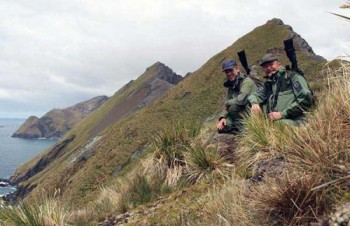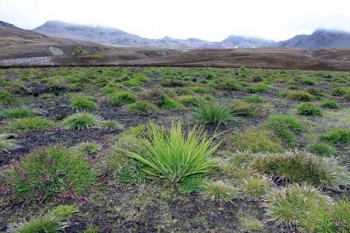ACAP Latest News has previously reported a number of times on ongoing efforts to remove introduced Reindeer Rangifer tarandus from South Georgia (Islas Georgias del Sur)* in the South Atlantic with an aerial survey last month confirming that at least 21 animals remained on the island (click here). News is now in that the alien herbivore may have been finally eradicated from the island with a total of 44 being shot by marksman this year on the Barff Peninsula. As a consequence vegetation is recovering in the absence of Reindeer to the eventual advantage of burrowing petrels, including the ACAP-listed White-chinned Petrel Procellaria aequinoctialis.

Reindeer on South Georgia with King Penguins, photograph by Martin Collins
Environment Officer Jennifer Lee’s account is given below.
“Following many years hard work of planning, and two years of field operations, in January two marksmen from the Norwegian Nature Inspectorate (SNO) made one final sweep of the Barff Peninsula in order to locate and shoot any reindeer that remained.

The two SNO marksmen on newly named Ranger Ridge

One of the marksmen searching for any remaining reindeer on the Barff Peninsula. Photograph from SNO
The operation to eradicate reindeer from South Georgia began in 2013. A combination of herding and ground shooting were used in the Busen area with Sami herders gathering around 1,000 animals and SNO ground shooters removing another 1,000 animals from areas where the terrain meant herding was not possible. As shooting in the Busen area took less time than anticipated, marksmen were also deployed on the Barff Peninsula where a further 1,555 reindeer were killed. The following year, a team of six marksmen worked to remove the remaining reindeer on the Barff Peninsula and were successful in shooting 3,140 animals.
In the months since the main cull of the Barff heard took place, field parties and aerial searches had been undertaken to determine how many reindeer remained and where they were located. In January 2015 two of the SNO marksmen returned to conduct a final sweep. Just prior to their arrival HMS Dragon visited the island and identified a group of 21 reindeer close to the tip of the peninsula. In an incredible feat of efficiency and professionalism, within 6 hours of being deployed to the field, the two marksmen [had] shot these 21 animals and harvested some of the meat ready for collection the next day by staff from KEP.
As expected, in the absence of reindeer, vegetation has started to recover from the severe overgrazing it had been subject to for more than 100 years. Interestingly, the marksmen were able to use this to their advantage and could often determine where the reindeer were located by looking at the height and composition of the vegetation. In areas where even a small number of reindeer persisted, the grass was short and cropped whereas the valleys, which had had a year to recover, were lush and thickly vegetated.

Early signs of vegetation recovery now the reindeer have gone. Photograph from SNO
In the subsequent three weeks, the marksmen worked their way south and shot a further 15 animals at Penguin Bay, 5 at the top of Sorling Valley and 3 close to St Andrews Bay. This brings the total number of reindeer killed on the Barff Peninsula to 4,739, and the total number of reindeer eradicated on South Georgia to over 6,700. In the coming weeks, eagle eyed field workers and helicopter pilots will continue to search for any signs of reindeer.”
Reference:
Lee, J. 2015. Clean sweep? South Georgia Newsletter January 2015.
John Cooper, ACAP Information Officer, 24 February 2015
*A dispute exists between the Governments of Argentina and the United Kingdom of Great Britain and Northern Ireland concerning sovereignty over the Falkland Islands (Islas Malvinas), South Georgia and the South Sandwich Islands (Islas Georgias del Sur y Islas Sandwich del Sur) and the surrounding maritime areas.

 English
English  Français
Français  Español
Español